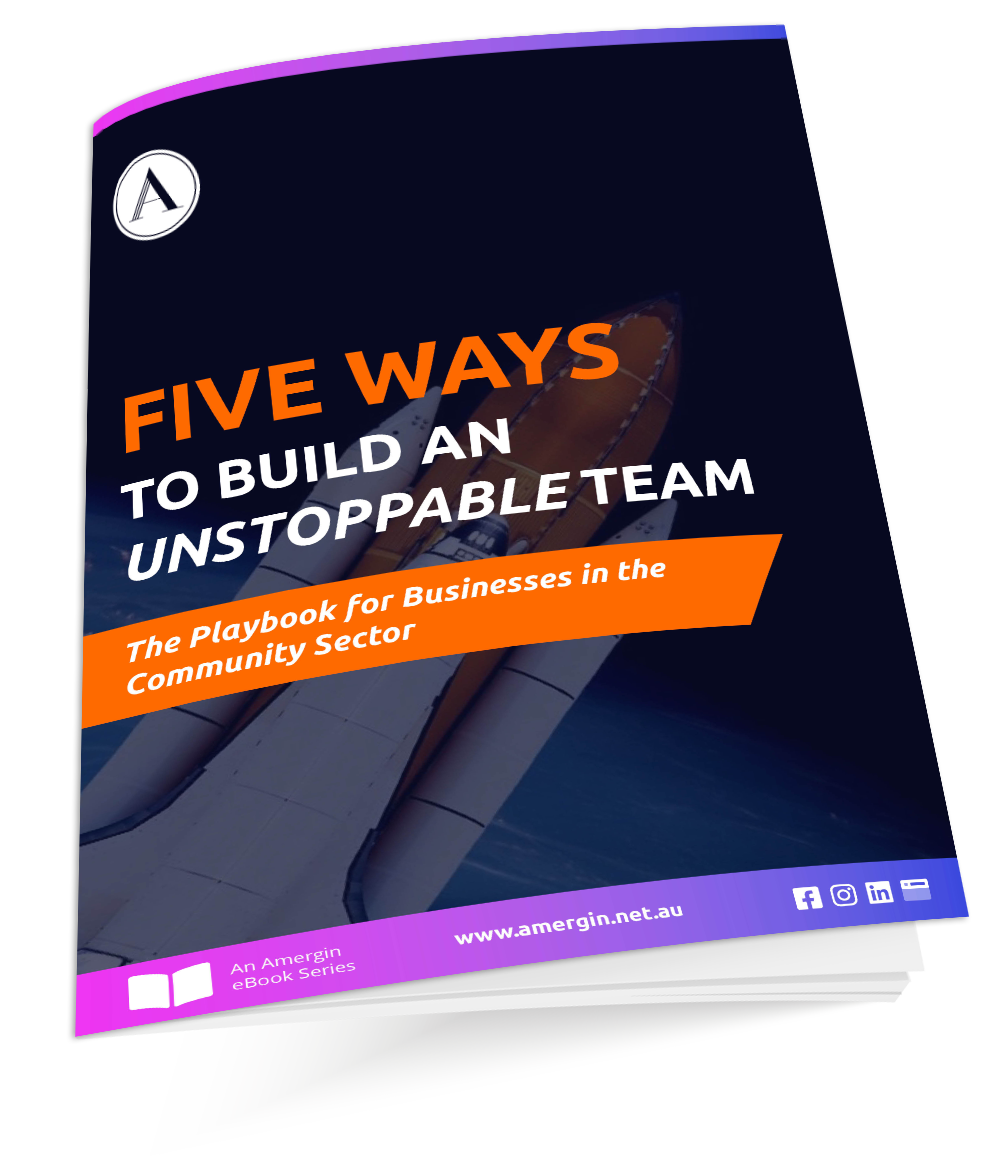The post Team Building Activities – Setting Intentions With Your Team appeared first on Amergin.
]]>Welcome back to Part 3 of our Mindfulness May series, where we discuss mindfulness practices you can implement within your team to support the mental health of your staff members.

Team building activities are an important step to building an inclusive and productive team culture. At the beginning of every week, Amergin’s team get together and we each discuss our week’s workload, our goals for the day and the week, and our intention for the week.
So what’s the difference between setting goals and setting intentions?
Setting a goal helps us to see the future, understand what we want, create a plan, and stay on track to get it done.
Setting intentions differ because they are not something you have to do. An intention is intangible, something that is felt. Often, intentions align with the goals we have set, but they connect us to the truth of who we are as we interact in each moment.
Encouraging your staff to adopt this practice of setting weekly goals and intentions is not only good business practice, but is also a simple way you can check in on how your staff are going. For example, your staff may have a long list of goals to achieve for the week but if their intention is to “find the balance” and they seem tired, stressed or generally not their usual self; this should be a prompt for you to check in, see how they are going and if there is any support you can offer to them.
Setting and living your intentions allows you to:
- focus on who you are in the moment;
- reflect on how you wish to contribute to the world;
- recognise and live your values;
- choose to touch the lives of others and;
- raise your emotional energy, which in turn raises your physical energy.
They also provide a roadmap and reminder for how to live out each day. Intentions give you purpose, as well as the inspiration and motivation to achieve your purpose. The practice of setting daily intentions can be life changing, both personally and professionally.
What Are Some Benefits of Setting Intentions?
Intentions Have No Limits
The wonderful thing about intentions is that you can set a new one each day, or you can set multiple for one day. The possibilities are endless when it comes to setting intentions, there’s no such thing as having too many. Creating a purpose for that day forces you to be present, forgiving yourself from the past and alleviating you from any future anxieties.
Intentions Affect Every Aspect of Your Life
Setting intentions will impact how you show up to daily activities – everything from your professional activities as well as your physical ones like working out can integrate your intention. The same intention will present itself in disparate areas of your life, with power to transform your mind, body, and soul.
Intentions Keep You Centred
The power of an intention, whether it’s just one or several, is that they can be experienced all at once, ensuring that you feel whole. Setting intentions ensures that you don’t feel that something is missing or lacking in your life. In this moment, intentions promise you feelings of presence, awareness, and fullness – all of which can foster a sense of grounding for your staff which reduces anxiety.
Intentions Improve Your Effectiveness
By setting your intention, your subconscious has a magical way to ensure that opportunities to practice that intention appear in small and big ways. A positive intention leads to a positive attitude. And a positive attitude unblocks barriers and increases productivity. Plus a positive workplace, is a happy workplace, which support happy staff and clients.
Intentions Make You More Mindful
You can fully immerse yourself in the present moment and not become fixated on what you don’t have yet. Doing everything with intent will also help you to become more in tune with your spiritual being. This can help you to approach your life more spiritually, and it will open your heart and mind. When you do this, it paves the way to naturally achieve your goals.
It also can help create a mindset that breaks up the never ending “to-do” list of priorities within the workplace, into smaller and more achievable goals that link with your intention.
Here are some examples of Intentions.
- I intend to live in gratitude for all that I have and all that I am.
- I intend to respond first and then react.
- I intend to lead by example.
- I intend to be open to success and abundance.
- I intend to stop taking things personally.
- I intend to forgive others, and myself.
- I intend to go with the flow.
- I intend to be true to myself.
Remember – Keep it simple. Make your intentions something you can achieve. Just do what feels right for you. Keep them realistic. Write them down. Get creative with colours and hand lettering. Place them on a vision board, your desk, your computer or wherever you can see them to remind you.
If you’ve never set intentions before, why not set an intention to start setting intentions as your first of many team building activities?
Where do I start?
If you want to get started on building a high performing team that are engaged and productive, you can download our Free eBook – Five Ways to Build An Unstoppable Team
Just click the link and enter your email address and we’ll send it to your inbox.
If your staff are disengaged or underperforming, you’re battling a tense work environment culture or you’re struggling with poor customer service, it’s a sign you may be dealing with an unhealthy team.
The post Team Building Activities – Setting Intentions With Your Team appeared first on Amergin.
]]>The post Mindfulness May – Mindfulness Practices You Can Implement Within Your Team appeared first on Amergin.
]]>Welcome back to Part 2 of our Mindfulness May series, where we discuss mindfulness practices you can implement within your team to support the mental health of your staff members.

If we could do just one thing to increase our health and happiness, expressing gratitude might just be the answer.
Did you know every time a person expresses or receives gratitude, dopamine releases in the brain? Dopamine is a chemical and plays a role in how we feel pleasure. It’s a big part of our unique human ability to think and plan, so the more we practice gratitude, the more often dopamine releases.
Our brains can’t focus on positive and negative things at the same time. This is a key reason why practicing gratitude can help you shift your focus from being sad about the things you don’t have in your life to being glad for the things you do have.
When we’re going through difficult times it can be hard to remember to be grateful for the good things and this is particularly important within the workplace. If your team are consistently experiencing high levels of stress, overworked or on the verge of burnout, it can be very difficult to pinpoint the reasons they enjoy their work, industry or why they are good at what they do.
There is merit to be gained from working gratitude into everyday practice, whether it be through online team conversations or expressing gratitude towards your staff to begin fostering the culture within your organisation.
What are the benefits of Gratitude?
- it’s an instant mood booster and feels great in the moment
- you’re likely to notice the little things in your day
- it’s good for your physical health
- it enhances your relationships and friendships
- you’re likely to enjoy your life more
- it gives you strength to access coping mechanisms to help you through the tougher times
Overall there is a greater sense of feeling connected to others with a more optimistic view towards life.
How Can We Practice Gratitude?
Gratitude is a skill anyone can develop. All it takes is a bit of daily practice. There are many ways we can practice gratitude both in our personal lives and within the workplace. Here are 9 examples of ways you can practice gratitude.
- Tell your staff regularly how much you appreciate them and their efforts within their work practice. Thank them for the little things they do for you, things you may take for granted.
- Notice the beauty in nature each day. The beautiful tree that give us a cool shade on a warm day. The sun, which occasionally shines through the clouds to lift our spirits. A cool sea breeze with its saltiness and depth reminding us of the vastness of the ocean. Encourage your staff to take their lunch breaks away from their desks (we are all guilty of this from time to time) and step outside for some Vitamin D and mindfulness.
- Volunteer. Not only does volunteering helps you connect with your community in a deeper way but it helps to make it a better place. It also helps you see that even the smallest tasks can have a huge impact on another person’s life. This doesn’t mean you have to encourage your staff to engage in volunteering activities as part of their work practice. It can be the simple act of volunteering to take over a task from another staff member whose schedule might be overloaded that week or putting your hand up to help cover work duties for a staff member who is unwell. As a business owner, you play a big role in establishing your workplace culture and supporting your team is a vital part of that.
- Thank the people who serve you in the community – bus driver, building manager, office cleaner etc. Everyone needs to feel appreciated and kindness goes a long way.
- Surround yourself with quotes and images of what brings you joy and happiness and encourage your staff to do the same. Walls and dividers with no colour or meaning are boring and uninspiring. Sometimes that little inspirational quote or photo can make a difference to a staff members day.
- Be thankful when you learn a new skill – you’re never too old to learn something new. Encourage your staff if they want to expand their learning opportunities as not only will this provide further learning from your organisation, but it reinforces the value you see in your staff.
- See the growth opportunity in your mistakes. Remember this is merely one moment in time. It only defines you and your worth if you choose to make it a defining moment. It’s also important that you work alongside staff members if and when they make a mistake, to a) prevent it from re-occurring and b) foster a relationship of continuous improvement within your team.
- Nurture all relationships and encourage your team to do the same. Our relationships foster warmth, caring and empathy and it is important that your team feel supported not only from one another but you as their leader within the organisation as well.
- Be grateful for the gift of you. Our relationship with ourselves determines our relationship with everything else. Be grateful for the unique, wonderful, inspiring human being that you are. Each member of your staff brings a wealth of knowledge, experience and a unique personality that helps shape the support your organisation offers to others.
Where do I start?
If you want to get started on building a high performing team that are engaged and productive, you can download our Free eBook – Five Ways to Build An Unstoppable Team
Just click the link and enter your email address and we’ll send it to your inbox.
If your staff are disengaged or underperforming, you’re battling a tense work environment culture or you’re struggling with poor customer service, it’s a sign you may be dealing with an unhealthy team.
The post Mindfulness May – Mindfulness Practices You Can Implement Within Your Team appeared first on Amergin.
]]>The post Mindfulness May – A series of mindfulness practices to incorporate within your team appeared first on Amergin.
]]>Regardless of where your team is working, even if it is remotely from the other side of the country, this doesn’t prevent you from implementing a series of simple practices within your everyday operations to help support your staff during moments of stress.
When our body responds to stress, one of the first reactions we have is our breathing usually changes to shorter, faster breathes that don’t extend down to the depths of our diaphragm. This is known as chest breathing and as your breath’s are shallower, this in turn feeds the stress response your body has entered.
That’s why the phrase “take a big breath in” is one of the most common phrases we hear when faced with a stressful situation. So why do we struggle so much with the concept of just stopping for a moment to re-focus our breathing?
We all know that stress raises our cortisol levels, resulting in a magnitude of impacts upon the human body including difficulties with emotional regulation and impaired brain activity. Essentially, the more stressed we are, the more likely it is that we will struggle within our everyday lives, tasks and work functions.
From a workplace perspective, stressed out staff may find their regular work practices and projects can suddenly seem harder, unachievable or impossible within the given timeframe. The usual mental clarity required to focus at the job at hand is clouded by the stress lens, which will continue to dominate individuals emotional regulation and focus unless the stress response is broken.
Which is where mindfulness practices play an important role.
This week’s Mindfulness May Practice is to – JUST BREATHE
The very simple act of deep breathing is a pretty miraculous healing exercise. It is involuntary for the most part and occurs naturally without us being aware. However, it is also an action we can control and regulate. Our ability to manipulate the breath makes it a valuable tool that can influence our minds and bodies and guide us towards a state of greater clarity and relaxation.
The breath is connected to the nervous system and by simply taking deep breaths in and out, we deactivate the ‘fight and flight’ or ‘stress’ response and activate the ‘rest and digest’ response of the nervous system. This immediately slows down our heart rate, brings more oxygen into our bloodstream and releases those ‘feel good’ endorphins throughout our entire body, allowing it to calm and settle, reducing anxiety and bringing us into the present moment.
This is an easy 5 minute breathing exercise you and your staff can do together prior to commencing your work day, to bring calm and relaxation to your body and team.
- Breathe in through your nose for 6 seconds. Remember to fill the abdomen, not just the chest. A simple way to make sure you are doing this is to place one hand on your belly and one on your chest.
- Hold the breath for 3 seconds.
- Release the breath out through your mouth for 6 seconds as though you’re releasing a big sigh.
- Repeat this 6 second cycle and as you continue to breathe in, focus on your breath as you feel it entering your nostrils into your body filling you with life.
- As you breathe out, release your thoughts with the breath. Let go of the things you have to do today or projects that need your attention. Simply let your thoughts rise and fall of their own accord and be at one with your breath.
- Continue to deep breathe until you begin to feel your mind calm and your body relax.
You may like to develop your own mantra and encourage your staff to do the same, to say on the inbreath and on the outbreath, to help you focus on your breathing. For example, Accounts Manager Sue’s mantra on the inbreath is “I’m breathing in the good” and her outbreath mantra is “and letting go of the bad.
You can now go about your day knowing you can integrate this practice as often as you like any time across the day. Some smart devices (such as the Apple Watch) have inbuilt apps or programs that can remind you to check in with your breathing and help you stay on top of your breathing throughout the day.
Just Remember, no matter what situation you are faced with and your stress levels begin to rise, take a moment or two and … Just Breathe.
Where do I start?
If you want to get started on building a high performing team that are engaged and productive, you can download our Free eBook – Five Ways to Build An Unstoppable Team
Just click the link and enter your email address and we’ll send it to your inbox.
If your staff are disengaged or underperforming, you’re battling a tense work environment culture or you’re struggling with poor customer service, it’s a sign you may be dealing with an unhealthy team.
The post Mindfulness May – A series of mindfulness practices to incorporate within your team appeared first on Amergin.
]]>The post Why Your Team Culture is Eating Your Strategy for Breakfast appeared first on Amergin.
]]>
It’s no secret that without a business strategy, you don’t get results. Your strategy is your map to achieving your objectives and your vision. But here’s the thing – your team culture eats your strategy for breakfast.
Does that sound familiar? “Culture eats strategy for breakfast” was made famous by well-known management expert, Peter Drucker.
When you break it down, it means no matter how powerful your strategy is, its success relies on the people who deliver it.
When you have an engaged, high-performing team, your business thrives. Your team are aligned with the values and direction of your business and want to go the extra mile.
However, when your team is showing unhealthy signs, not only is your strategy impacted, so is your team morale, your client services and your bottom line.
The signs of an unhealthy team culture aren’t always obvious.
They can start off small – an under-performing team member isn’t making progress or poor client feedback is starting to become more regular. When you don’t have the right strategy to manage these, the problems can escalate.
There are five ways you can nip these issues in the bud and transform your team into a high-performing one.
To get started, download your free copy of our community sector playbook, Five ways to build an unstoppable team.
It will walk you through the mistakes to avoid and the changes you can start making today to build a high-performing team and accelerate results in your business.
And if like many businesses your strategy has taken a hit this year, or gone out the window, you can get your free 2020 Strategic Planning Guide to drive your business forward with certainty and clarity.
With a high performing team and a solid strategy, you’ll have a winning combo to charge into 2021 in full swing!
Where do I start?
If you want to get started on building a high performing team that are engaged and productive, you can download our Free eBook – Five Ways to Build An Unstoppable Team
Just click the link and enter your email address and we’ll send it to your inbox.
If your staff are disengaged or underperforming, you’re battling a tense work environment culture or you’re struggling with poor customer service, it’s a sign you may be dealing with an unhealthy team.
The post Why Your Team Culture is Eating Your Strategy for Breakfast appeared first on Amergin.
]]>The post MS Brissy to the Bay – 30 for 30 Challenge Complete appeared first on Amergin.
]]>
The ride to fight MS is done and dusted for another year, and in our short three year stint of joining the MS Brissy to the Bay, it’s safe to say that this was the most challenging yet.
The impacts of COVID-19 forced organisers to rethink the traditional single day event and instead introduce a virtual challenge that combined with the Brissy to Bay’s 30 year anniversary. Aptly named the 30 for 30 challenge, riders were urged to set their own distance goal to cycle throughout the month of June, and record their progress using fitness applications such as Strava or Fitbit.
As always, the Amergin team went into this year’s event both excited and quietly confident that we would once again complete the challenge by whatever means possible, no matter how hard or gruelling the ride – or rides – would become. This confidence was apparent in the optimistic distance goals that were set by the team:
We soon came to realise that the distance would not be the only challenge we would face. From getting lost in fire trails of Gap Creek, to back injuries, ankle injuries and everything in between, much of the month was spent nursing wounds while trying our best to stay on top of the mammoth task we had set. Throw into the mix trying to manage a healthy work/life balance and the added mental toll, life just was not the same for a short period of time.
“Although barely scraping the surface, this lifestyle over the past month has highlighted to me the difficulties those living with MS must face daily” – Jeffrey Pumfrey.
Despite the setbacks, I’m proud to say that all four of us put in a commendable effort with the following results:
Finally, and most notably, thanks to the wonderful support received from friends, family, colleagues and clients, the Amergin team raised as phenomenal $2,005 out of our initial $1,000 fundraising goal, which will help change the lives of 4,000 Queenslanders living with multiple sclerosis (MS).
If you would like to look at our results further, you can take a look at our team fundraising page on the MS Brissy to Bay website.
The post MS Brissy to the Bay – 30 for 30 Challenge Complete appeared first on Amergin.
]]>The post Wellbeing in the Workplace: 4 Tips to a Healthier You appeared first on Amergin.
]]>
What is wellbeing in the workplace? According to the dictionary, Wellbeing is defined as ‘the state of being comfortable, healthy and happy’. In other words, Wellbeing is a term used to describe Wellness across all areas of health, including both mental and physical wellbeing.
The research into the connection between health and wellbeing and workplace performance has identified employee wellbeing has a critical impact on a workplace’s long-term effectiveness and productivity levels. Put simply, progressive workplaces are doing so because they appreciate and value their most important human resources – their people. Evidence is demonstrating, that workplace investment in Wellbeing is achieving great results.
In today’s hectic world, the workplace can feel like an emotional roller coaster. Long hours, tight deadlines and ever-increasing demands can leave you feeling worried, drained, and overwhelmed. A moderate level of stress can be both healthy and productive but if faced with high stress levels over a sustained period of time, you fatigue more easily and your performance can suffer. Even worse – chronic stress affects your physical and mental health leading to increased risk and intensity of depression, anxiety, headaches and other symptoms.
Every business has a legal and moral responsibility to provide a safe and fair workplace to support individual mental health and lead to reduced absenteeism, increased employee engagement and improved productivity, however employees also have a responsibility to take ownership for their own health and wellbeing. So what actions can be adopted on a personal level to manage and reduce your stress levels, as well as finding a positive work-life balance?
Learning a few simple ‘relaxation techniques’ is paramount to managing stress. When you relax, the flow of blood increases throughout your body giving you more energy. It helps you to have a calmer and clearer mind which aids positive thinking, concentration, memory and decision making. Relaxation slows your heart rate, reduces your blood pressure and relieves tension. It also aids digestion as you absorb essential nutrients more efficiently when relaxed, which helps to fight off disease and infection. Here are a few relaxation techniques which can have a profound effect both in your personal life and in the workplace.
Practice Deep Breathing – When in Doubt, Breathe Out
The very simple act of deep breathing is a pretty miraculous healing exercise. It is involuntary for the most part and occurs naturally without you being aware. However, it is also an action you can control and regulate. Your ability to manipulate the breath makes it a valuable tool that can influence your mind and body and guide you towards a state of greater clarity and relaxation.
The breath is connected to the nervous system and by simply taking deep breaths in and out, you deactivate the ‘fight and flight’ or ‘stress’ response and activate the ‘rest and digest’ response of the nervous system. This immediately slows down your heart rate, brings more oxygen into your bloodstream and releases those ‘feel good’ endorphins throughout your entire body, allowing it to calm and settle, reducing anxiety and bringing you into the present moment.
Set Intentions – What do you Want?
What’s the difference between setting goals and setting intentions?
Setting a goal helps you to see the future, understand what you want, create a plan, and stay on track to get it done.
Setting intentions differ because they are not something you have to do. An intention is intangible, something that is felt. Intentions give you purpose, as well as inspiration and motivation to achieve your purpose. Setting and living your intentions allows you to –
Practice Gratitude – The Attitude of Gratitude
If you could do just one thing to increase your health, happiness and wellbeing, expressing gratitude might just be the answer.
Did you know every time a person expresses or receives gratitude, dopamine releases in the brain? Dopamine is a chemical and plays a role in how you feel pleasure. It’s a big part of your unique human ability to think and plan, so the more you practice gratitude, the more often dopamine releases.
Your brain can’t focus on positive and negative things at the same time. This is a key reason why practicing gratitude can help you shift your focus from being sad about the things you don’t have in your life to being glad for the things you do have.
When you’re going through difficult times it can be hard to remember to be grateful for the good things, but many benefits can be gained from working gratitude into your everyday life.
Self Care – Make Time for You
Self-Care refers to the activities and practices that support your physical, emotional and mental health. Contrary to what some people believe, self-care doesn’t have to be lavish or expensive. It’s often the simplest things that make the biggest difference. Far from indulgent, try to view self-care as a necessity for the pace and pressure that life can place on you.
It can be a difficult lesson for many to learn, but to be truly at your best, both for yourself as well as the people around you, you need to make self-care a priority.
Here are some easy ways to help you care for yourself.
Mindful Moments
Self-care can be as simple as slowing down and pausing multiple times during the day whether at home or in the workplace. You might do this by simply taking three long, slow deep breaths or by consciously engaging your senses for a few moments. Look out the window and focus on something away from the task at hand. Daydream! Doing this can be surprisingly powerful as it can help you to ‘reset’ during even the busiest of days.
Move Your Body
Exercise can help with anxiety by reducing the activity of the ‘fight or flight’ response in the body. People who experience anxiety can fear or resist the physiological changes associated with anxiety such as a rapid heartbeat and shortness of breath. Regular movement can help to develop a tolerance for these sensations and it’s also a great way to boost your mood.
Make Time For Rest
We live in a culture that overvalues busyness and often views rest as unproductive or lazy. However, rest gives you the opportunity to slow down, calm your overactive nervous system and reconnect to the things and people that are most important to you. When you’re well rested you’re better able to access your intuition and creativity. Dedicate time in your lunchbreak to ‘rest and digest’.
Communicate Your Needs
Reach out and tell others what you need or ask for help. It can be tempting to think that people who care about you and work with you should already know what you need, however unless you clearly communicate what it is you’re needing in that moment, you can’t assume people will know.
Prioritise Your Priorities
Good time management is essential to success. And it’s not limited to success in the workplace. Success as a friend, parent, spouse, fitness, anything… requires good time management skills. Success in any endeavour requires giving it the proper amount of time at the right time.
Wellbeing doesn’t have to be out of reach when you have the right tools and it doesn’t have to be expensive. Relaxation is one of the most effective self-help activities for good mental and physical health and wellbeing, as well as being an effective measure to prevent the development of stress and anxiety.
In reality, relaxation can be one of the healthiest things to incorporate into your everyday personal and work life.
Want to be kept up to date with more Wellbeing in the Workplace tips and techniques? Follow us on Instagram, Facebook or join our mailing list below.
The post Wellbeing in the Workplace: 4 Tips to a Healthier You appeared first on Amergin.
]]>The post Amergin’s Brissie to the Bay Ride 2019 appeared first on Amergin.
]]>This year’s team consisted of 6 members who all completed the 100km leg of the journey:
- Anthony Gatehouse (Captain)
- Jeffrey Pumfrey
- Tarin Glazier
- Adam Johnson
- Joel Keenan
- Paul Mcandrew
The team managed to raise a total of $1573.87 which is the equivalent of 10 shower chair installations for people living with MS.
We’re all very much looking forward to next year’s event and a HUGE thank you to all of those who contributed a donation!
The post Amergin’s Brissie to the Bay Ride 2019 appeared first on Amergin.
]]>